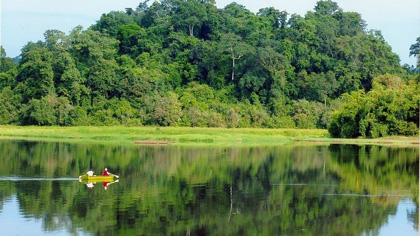Symposium discusses how sci-tech helps preserve biological diversity
How science and technology contribute to preserving biological diversity and sustainable development of UNESCO-recognised biosphere reserves in Vietnam was put on the table for discussion at a symposium held in Hanoi on May 11.
The symposium was jointly held by the Ministry of Science and Technology (MOST), Vietnam National Commission for UNESCO, UNESCO's Man and the Biosphere Programme (MAB), and the Hanoi National University of Education as an event to mark Vietnam Sci-tech Day (May 18).
 |
| Cat Tien National Park is one of eight UNESCO world biosphere reserves in Vietnam (Photo: VNA) |
Speaking at the event, MOST Deputy Minsiter Pham Cong Tac said that biosphere reserves not only help bring people closer to nature, but also protect indigenous genetic resources, plant and animal species, and indigenous culture.
He stressed the need for local residents to protect the environment and ensure sustainable development in biosphere reserves.
He also acknowledged difficulties in managing and protecting biosphere reserves in Vietnam, which is a consequence of the lack of experiences and simple investment in the work.
Participating scientists at the event discussed solutions for localities to address the problems and suggested pilot models reconciling the conservation of biodiversity with sustainable use in the areas.
Vietnam now has nine world biosphere reserves recognised by UNESCO: Can Gio (2000), Cat Tien national park (2001), Cat Ba archipelago (2004), the Red River Delta (2004), Kien Giang (2006), western Nghe An (2007), Cu Lao Cham-Hoi An (2009), Ca Mau Cape (2009), and Langbiang Natural Reserve (2015).
Since 2015, the MOST has co-ordinated with the Vietnam National Commission for UNESCO and the MAB to review problems facing the nine biosphere reserves, such as how to balance the harmony between biological diversity conservation, and economic development and cultural preservation.
According to UNESCO, biosphere reserves are areas comprising terrestrial, marine and coastal ecosystems. They are ‘Science for Sustainability support sites’ – special places for testing interdisciplinary approaches to understanding and managing changes and interactions between social and ecological systems, including conflict prevention and management of biodiversity.
There are 669 biosphere reserves in 120 countries, including 16 trans-boundary sites.
(Source: NDO)
 về đầu trang
về đầu trang







